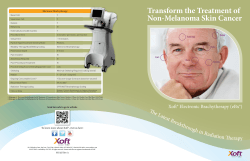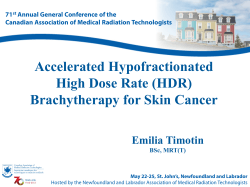
UC SF Thermal Therapy of Cancer Paul Stauffer
Thermal Thermal Therapy Therapy of of Cancer Cancer Paul Stauffer Chris Diederich Jean Pouliot Radiation Oncology Dept. University of California, San Francisco stauffer@radonc17.ucsf.edu UC SF Hyperthermia Definition Mechanisms Rationale: Thermal Enhancing Ratio (TER) Dosimetry Overview of Technology for Thermal Therapy Clinical Applications Hyperthermia T = 41-45°C for 30-60 min ΔT = 4 - 8°C Dose = Cumulative Equivalent Minutes at 43°C for the T90 90 temperature (CEM43ooCT) Hyperthermia Mechanisms • Increases perfusion, permeability, pH, pO22 • Increases metabolic activity, drug uptake • Radiosensitization, Chemosensitization • Some cell kill at higher temperatures/doses Hyperthermia Rationale The synergistic effect of heat and radiation is quantified by the Thermal Enhancement Ratio (TER) defined as: RT dose without heat TER = RT dose for equivalent effect with heat C3H Mammary Carcinoma (a) (b) (c) Fig. 2 – Rationale for combining heat and radiation for treatment of recurrent chestwall disease. Data from demonstrates: (a) increased TER for simultaneous heat and radiation in C3H mammary carcinoma, (b) clinical impact of TER=1.5 obtained from a compilation of human data in the literature, and (c) TER up to 5.0 for simultaneous heat and radiation in C3H mammary carcinoma compared to TER plateau of 2.0 for sequentially applied modalities. Dosimetry Heating device Temperature elevation Body is thermally auto-regulated Heating an organ is like bringing a heater in an air conditioned room! Feedback Control / Power Steering Heating Mechanisms Thermal conduction Electromagnetic RF, MW Mechanical friction US Interstitial Interstitial // intracavitary intracavitary External External Interstitial Interstitial // intracavitary intracavitary External External Interstitial Interstitial // intracavitary intracavitary Clinical Applications of Thermal Therapy Hyperthermia (41 - 45oC or < 100 CEM) Cancer Therapy with Radiation or Chemotherapy Heat-Activated Gene Therapy, Liposome Release Accelerate Wound and Bone Healing Organ Preservation (Stimulate Heat Shock Proteins / Rewarming) Thermal Thermal Therapy Therapy Treatment Treatment Options Options Cryotherapy Hyperthermia Thermal Ablation T = < - 50°C for >10 min ΔT = - 90°C T = 41-45°C for 30-60 min ΔT = 4 - 8°C T > 50°C for >4-6 min ΔT = > 13°C Mechanisms Mechanisms Mechanisms Freeze/Thaw transition disrupts cell membrane Complete cellular destruction Increases perfusion, permeability, pH, pO2 Increases metabolic activity, drug uptake Radiosensitization, Chemosensitization Some cell kill at higher temperatures/doses Potential HT Techniques Potential HT Techniques Thermal Conduction External RF, MW, US Interstitial - Intracavitary RF, MW, US Thermal Conduction Ferroseeds, Thermorods DC Resistance Wires Hot Water Tubes Laser/Fiberoptic Diffuser Crystals Equipment Availability Equipment Availability 100% Commercial 40% Commercial 60% University - Under Development Protein Denaturization Necrosis Coagulation Not subtle effects Potential HT Techniques External Scanned Focused US Large Focused US Arrays Interstitial - Intracavitary RF, MW, US, Laser Thermal Conduction Equipment Availability 75% Commercial 10% PMA 50% IDE Trials 40% Under Development 25% University - Under Development Devices and Techniques for Heating Tissue Available Heating Modalities Thermal Conduction Equilibrium of Thermal Gradients Electromagnetic Radiofrequency Current Electron Flow between Atoms Joule Heating Microwave Radiation Oscillations of Polar H2O Molecules Dielectric Heating Laser Absorption of Light Energy Ultrasound Pressure Wave Compression – Expansion Forces Mechanical Friction Losses Superficial Heating Electromagnetic Techniques Waveguide / Horn Single or multiple aperture arrays Phased or non-phased arrays Stationary or robotically scanned Microstrip Applicators Single or multiple aperture Planar or conformal Spirals - Stationary or scanning Patches, annular slots, etc Dipole Surface Array Stationary or scanning RF Capacitive Plate Hybrid Inductive loop “current sheet” Multimode feed “HEMA” Laser Superficial Hyperthermia 434 MHz Microwave - Deeper Penetration Conventional 10x10 Horn Waveguide Lucite Cone Waveguide Reitveld & VanRhoon IJH 1999 Lucite Cone Applicator Gerard VanRhoon Current Sheet Applicators (CSA) Multiple Frequencies - 915, 433 Phased Array - Deeper Penetration J Hand, M Gopal, T Cetas Microstrip Applicators Stanford Stanford Blanket Blanket Lee, Lee, Fessenden, Fessenden, Kapp Kapp Flexible Flexible Conformal Conformal Microwave Microwave Array Array Applicator Applicator 66 mm mm Water Water Bolus Bolus 24 24 Aperture Aperture CMA CMA 16 16 Aperture Aperture CMA CMA Vest Bolus 40 40 Aperture Aperture CMA CMA 47 47 xx 29 29 == 1363 1363 cm cm22 Stauffer, Stauffer, Rossetto, Rossetto, Neuman Neuman Possible Treatment Configurations Patient’s Preference Standing - Pacing Lying Down Sitting Thermometry Solutions for the Future 2D 2D Thermal Thermal Monitoring Monitoring Sheet Sheet CMA Applicator MW Array Controller Thermal Monitoring Array Fiber Ribbon Cable Fiber Array Readout Ipitek Corp. Combination Combination Applicator Applicator Simultaneous Simultaneous Heat Heat and and Brachytherapy Brachytherapy L-Shape L-Shape 52 52 xx 32 32 cm cm Rectangular Rectangular 17 17 xx 35 35 cm cm Preparations for Simultaneous HT/RT Treatment Setup and Preplan 15 x 15 cm Target HDR 3D Conformal Dose Plan IPSA IPSA -------> -------> Plato Plato PCB Array 13x13x1 cm Target Water Bolus Skin Surface Contour Deep Heating Ultrasound Techniques Piston Transducer Unfocused Focused - Convex shape or Focusing lens Lightly - no gain Tightly - high gain Stationary or Robotically scanned Transducer Arrays Planar or Geometric focus Stationary lightly focused Stationary lightly focused - scanning reflector Mechanically or electrically scanned transducers Lightly focused transducer array Focused transducer array Radiofrequency Plate Electrodes 8 - 27 MHz Scanned Focused Ultrasound Spherical Section Array Focused Ultrasound Evolving Technologies – Deep Heating RF- 8 Sigma 60 Magnetrode 4 Antenna Pairs 1 Ring Sigma-Eye APAS 12 Ch, 24 Antennas 3 Rings 1 Power Channel 1982 1992 2002 Interstitial Multi-needle Multi-needle LCF LCF hyperthermia hyperthermia system system designed designed for for hyperthermia hyperthermia combined combined with with brachytherapy. brachytherapy. (Photos (Photos courtesy courtesy of of Peter Peter Corry, Corry, William William Beaumont Beaumont Hospital). Hospital). Interstitial Interstitial microwave microwave antennas antennas suitable suitable for for hyperthermia hyperthermia in in combination combination with with interstitial interstitial brachytherapy brachytherapy (with (with permission permission from from BSD BSD Medical Medical Corp.). Corp.). 13-g Catheter Ultrasound Applicator 4 x 10 mmApplicator 3 x 10 mm 2 x 10 mm Water-Flow Ports Quick-Connects RF Power 50 48 46 Temperature (C) (A) (A) Interstitial Interstitial ultrasound ultrasound applicators applicators suitable suitable for for heating heating in in combination combination with with HDR HDR brachytherapy; brachytherapy; (B) (B) CT CT image image of of aa brachytherapy brachytherapy implant implant pattern pattern in in the the prostate, prostate, with with directional directional ultrasound ultrasound applicators placed posterior posterior with with energy energy directed directed applicators placed anterior anterior to to protect protect the the rectum. rectum. (C) (C) Measured Measured temperature temperature profiles. profiles. 44 42 2 4 1 5 6 40 360 deg. US Applicators 3 38 36 34 Probe 1 - Catheter 1 Probe 2 - Catheter 2 Probe 3 - Catheter 6 Probe 4 - Catheter 3 Probe 5 - Catheter 5 Probe 6 - Catheter 4 Directional Ultrasound Applicators 32 30 0.0 0.5 1.0 1.5 2.0 Position (cm) 2.5 3.0 3.5 Evolutionary Evolutionary Trends Trends –– Heating Heating Capabilities Capabilities Generation First 1980’s Second 1990’s Simple Structures (e.g. Single Waveguide, Piston) Centrally Peaked SAR - Power Up / Down Control No pre-Tx planning or real-time adjustment of SAR 1-8 Stationary Temperature Sensors Small Treatment Volumes (e.g. < 3-4 cm diameter) Planar Arrays 2-D Treatment Planning - Lateral Adjustment of SAR 4 - 16 Controllable Sources 8 - 16 Temperature Sensors, Thermal Mapping Moderate Size Treatment Volumes Emerging Electrically or Physically Phase Focused Arrays Stationary Conformal Arrays Site-Optimized Applicators 2000 Non-Invasive Temperature & Physiologic Effect Monitoring Patient Specific Treatment Planning - 3-D Power Steering So Why Isn’t Everyone Offering HT (Depends (Depends on on Who Who You You Talk Talk To) To) Reimbursement rate too low Space and personnel demands too high Administrators Administrators Can not heat all patients/sites Can not deliver precise Tdose as prescribed Clinicians Clinicians Equipment is terrible Better equipment not available commercially Physicists Physicists Difficult to setup and deliver in many sites Uncomfortable for some patients Operators Operators Current Challenges - Biology • Optimum combination of HT with RT Long duration moderate vs. short duration high temp. HT Pulsed vs. continuous RT with simultaneous HT • Optimum administration of HT with CT Identify best compromise of temperature/thermal dose for Vessel permeability, extravasation, cell metabolism and uptake • Are we investigating all appropriate clinical applications Can we justify treating earlier stage disease/which More aggressive combinations of HT + RT + CT
© Copyright 2025





















